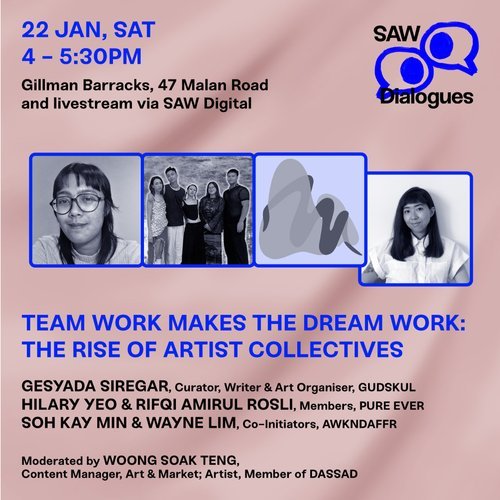SAW Dialogues 2022 | Connecting the Dots: Art and Blockchain
Clara Peh, Jonathan Liu, Wang Zineng, Kathleen Ditzig
By Wan Jie Che
Screenshot of talk. From left to right: Wang Zineng, Founder, Art Agenda, Jonathan Liu, Visual Artist and Lecturer; Founding Member, NFT Asia, Clara Peh, Founder, NFT Asia; Art Lead and Curator, Appetite, Kathleen Ditzig, Independent Curator.
Key points:
Blockchain technology will continue to shape the cultural infrastructure of the art market.
NFTs have lowered the barriers to entry for artists and collectors by providing ease of access and transaction.
The role of key traditional art market players, such as public institutions and curators, remain important in the NFT market.
There is a need for more critical discourse regarding the NFT artworks.
Kicking off the first talk of SAW Dialogues 2022, Clara Peh, Founder of NFT Asia and Art Lead and Curator of Appetite; Jonathan Liu, visual artist, lecturer, and founding member of NFT Asia; and Wang Zineng, Founder of Art Agenda, discussed blockchain technology and its impact on the future of art-making, dealing and collecting. The talk was moderated by independent curator Kathleen Ditzig.
Here are the takeaways:
Blockchain technology will continue to shape the cultural infrastructure of the art market. Zineng noted that blockchain technology can help to facilitate artwork transactions by providing transparency and a reliable provenance, which has been a perennial challenge in the traditional art market. With regard to copyright and authenticity when uploading a digital artwork online, Clara explained that while anyone can download the image of an artwork, NFTs (non-fungible tokens) allow artists to claim ownership to the digital asset due to its immutability and traceability. Jonathan pointed out that an issue with the current infrastructure is that it allows some artists and collectors to remain anonymous. Both Zineng and Clara emphasised that the NFT market is not radically different from the traditional contemporary art market as they share similar underpinning market forces.
NFTs have lowered the barriers to entry for artists and collectors by providing ease of access and transaction. Through his experience with NFT Asia, Jonathan observed that the digital space has allowed the convergence of artists from various backgrounds. Clara added that social media and NFT platforms provide a digital native community structure, hence artists can be connected to a wider audience. It also allows them to engage with collectors with a genuine appreciation for their artworks. Native users of cryptocurrency and blockchain technology can easily purchase digital artworks via NFT platforms, creating a closed digital loop. In response to Kathleen’s question about how interested individuals can enter the NFT space, Jonathan advised that they should educate themselves on the digital ecosystem, seek out credible communities for support and engage with the community to build connections, which was echoed by Clara. Zineng suggested keeping an open mind towards the aesthetics of digital art.
The role of key traditional art market players, such as public institutions and curators, remain important in the NFT market. Citing recent news that the British Museum will be launching NFTs of Hokusai prints, Zineng reflected on the importance of the role of public institutions in enabling access to renowned works of art and the fractionalisation of art ownership. Museums reinforce the importance of digital art by allowing the public to interact with them in non-traditional ways. Jonathan elaborated that physical exhibitions can be a validating experience for artists and their modes of practice. He opined that NFT communities exist digitally, hence public institutions can support them by providing a physical space to exhibit their artworks. Clara summarised that public institutions, specifically museums, can engage with the market in two ways: exhibiting NFT artworks or supporting curatorial efforts behind them and directly minting NFTs. Kathleen expounded on Clara’s point that museums have to consider the larger crypto landscape as public institutions have to cater to communal interests.
In response to an audience question on the role of curators in the NFT space, Clara described their role as individuals who weave a narrative between artworks and contribute to the shaping of art historical conversations. She underlined the need for curators in the digital art space to situate NFT artworks in relation to the NFT ecosystem and the wider art history. Kathleen tapped into her expertise as an independent curator and elaborated that curators have to be sensitive to the histories of display. Although the rise of NFTs have not catalysed an entirely new paradigm of modes of display, curators can enhance the critical discourse surrounding it.
There is a need for more critical discourse regarding the NFT artworks. Clara observed that the NFT ecosystem is developing rapidly, largely led by market forces. Critical discussions in this area, on the other hand, can function in tandem with the market. She suggests that there should be more dialogues and education on the NFT ecosystem to bridge communities that engage with NFTs and those outside of it. This can eventually lead to the sharing of good practices and greater academic discourse, which can encourage more critical curatorial thought between traditional art and NFTs. Zineng added that these recent developments provide an opportunity to think about pertinent issues relating to intellectual property and copyrights.
Watch the full recording of ‘SAW Dialogues 2022 | Connecting the Dots: Art and Blockchain’ here:
You can also listen to it as a podcast here:
About the writer:
Wan Jie Che is a contributor based in Singapore with a background in Economics and Art History. She is currently working in the financial sector and has interests in cultural economics, the art market, sustainability and innovation in organisations. In her spare time, she also volunteers at a local community arts space with programming, strategy and management.















